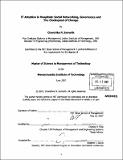| dc.contributor.advisor | Charles H. Fine. | en_US |
| dc.contributor.author | Samarth, Chandrika N. (Chandrika Nayantara) | en_US |
| dc.contributor.other | Management of Technology Program. | en_US |
| dc.date.accessioned | 2007-11-16T14:14:37Z | |
| dc.date.available | 2007-11-16T14:14:37Z | |
| dc.date.copyright | 2007 | en_US |
| dc.date.issued | 2007 | en_US |
| dc.identifier.uri | http://hdl.handle.net/1721.1/39502 | |
| dc.description | Thesis (S.M.M.O.T.)--Massachusetts Institute of Technology, Sloan School of Management, Management of Technology Program, 2007. | en_US |
| dc.description | Includes bibliographical references (p. 153-155). | en_US |
| dc.description.abstract | The healthcare industry is expanding swiftly and total healthcare expenditures are expected to reach 18% of GDP by 2008. However there exist steep variances in quality of care and high incidences of medical error. This has given impetus to efforts at progressively evolving the healthcare delivery system. The role of information technology (IT) is seen as being central to cost reduction and quality improvement of healthcare delivery. Furthermore, efficiency gains will realize approximately 20% in cost reductions. However, there are significant challenges associated with widespread adoption of IT by healthcare providers. Despite the existence of vendor and technology maturity, implementation rates for clinical patient record systems were only 35% in 2006. This study addresses the problem of low IT adoption in hospitals through a three pronged analysis methodology. A Clockspeed analysis has revealed a dichotomy between the maturity levels of technology and vendors on the one hand and delivery processes on the other. This has resulted in lower business value being realized from IT investments by healthcare providers. | en_US |
| dc.description.abstract | (cont.) To address the concern of low business value realization from IT investments, a workflow and Social Networking Analysis was conducted on the surgery patient flow process of a prominent Boston area hospital. It was demonstrated that productivity gains could be achieved through redesign of social networks at the workplace and by inculcating an enterprise-wide process orientation. This would generate greater business value from existing IT investments and thereby impact the rate of IT adoption. Furthermore, an assessment of IT Governance styles and IT Architecture maturity was done at the same Boston area hospital. The findings revealed the requirements necessary for migration towards an IT Architecture that could deliver data integration and an enterprise-wide process orientation. A top management driven approach towards a uniformity in governance styles and an alignment of business strategies throughout the organization were identified as the key requirements. The improved business value realized from IT investments through this combined approach makes the case for faster IT adoption by hospitals, and by extension, by healthcare providers in general. | en_US |
| dc.description.statementofresponsibility | by Chandrika N. Samarth. | en_US |
| dc.format.extent | 155 p. | en_US |
| dc.language.iso | eng | en_US |
| dc.publisher | Massachusetts Institute of Technology | en_US |
| dc.rights | M.I.T. theses are protected by copyright. They may be viewed from this source for any purpose, but reproduction or distribution in any format is prohibited without written permission. See provided URL for inquiries about permission. | en_US |
| dc.rights.uri | http://dspace.mit.edu/handle/1721.1/7582 | |
| dc.subject | Management of Technology Program. | en_US |
| dc.title | IT adoption in hospitals : social networking, governance and the clockspeed of change | en_US |
| dc.title.alternative | Information technology adoption in hospitals : social networking, governance and the clockspeed of change | en_US |
| dc.type | Thesis | en_US |
| dc.description.degree | S.M.M.O.T. | en_US |
| dc.contributor.department | Management of Technology Program. | en_US |
| dc.contributor.department | Sloan School of Management | |
| dc.identifier.oclc | 173667328 | en_US |
